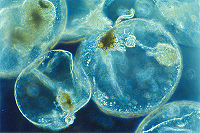Noctiluca scintillans
For the course duration, the article is closed to outside editing. Of course you can always leave comments on the discussion page. The anticipated date of course completion is May 21, 2009. One month after that date at the latest, this notice shall be removed. Besides, many other Citizendium articles welcome your collaboration! |
| Noctiluca scintillans | ||||||||
|---|---|---|---|---|---|---|---|---|
 | ||||||||
| Scientific classification | ||||||||
|
Description and Significance
Noctiluca scintillans, also known as sea sparkles, are single-celled dinoflagellates that exhibit bioluminescence. They are free-living marine plankton, which range between 200-2000 micrometers in diameter. They are mostly found in estuaries and other coastal regions and can be found in both warm and cold waters. N. Scintillans are heterotrophic and non-photosynthetic, meaning they receive their carbon from organic compounds and receive their energy through the ingestion of organic substances. They don’t have any chloroplasts so, their cytoplasm is relatively clear. Noctiluca scintillans are non-motile, even though they possess a flagellum, and only move vertically by changing their buoyancy using gas vacuoles. N. Scintillans can reproduce asexually, by binary fission, and sexually, using isogametes through a diplontic lifecycle.